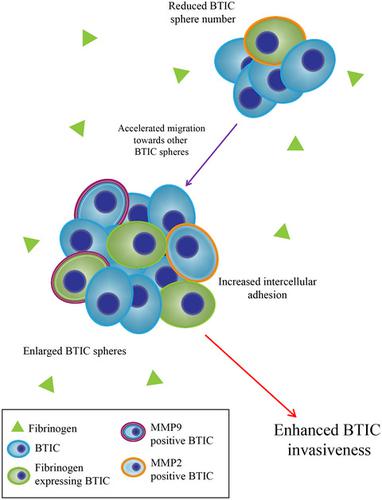当前位置:
X-MOL 学术
›
Brain Pathol.
›
论文详情
Our official English website, www.x-mol.net, welcomes your
feedback! (Note: you will need to create a separate account there.)
Fibrinogen in the glioblastoma microenvironment contributes to the invasiveness of brain tumor-initiating cells
Brain Pathology ( IF 5.8 ) Pub Date : 2021-03-10 , DOI: 10.1111/bpa.12947 Lauren Dzikowski 1 , Reza Mirzaei 1 , Susobhan Sarkar 1 , Mehul Kumar 2, 3 , Pinaki Bose 2, 3, 4, 5, 6 , Anita Bellail 7 , Chunhai Hao 7 , V Wee Yong 1, 3, 8
Brain Pathology ( IF 5.8 ) Pub Date : 2021-03-10 , DOI: 10.1111/bpa.12947 Lauren Dzikowski 1 , Reza Mirzaei 1 , Susobhan Sarkar 1 , Mehul Kumar 2, 3 , Pinaki Bose 2, 3, 4, 5, 6 , Anita Bellail 7 , Chunhai Hao 7 , V Wee Yong 1, 3, 8
Affiliation

|
Glioblastomas (GBMs) are highly aggressive, recurrent, and lethal brain tumors that are maintained via brain tumor-initiating cells (BTICs). The aggressiveness of BTICs may be dependent on the extracellular matrix (ECM) molecules that are highly enriched within the GBM microenvironment. Here, we investigated the expression of ECM molecules in GBM patients by mining the transcriptomic databases and also staining human GBM specimens. RNA levels for fibronectin, brevican, versican, heparan sulfate proteoglycan 2 (HSPG2), and several laminins were high in GBMs compared to normal brain, and this was corroborated by immunohistochemistry. While fibrinogen transcript was at normal level in GBM, its protein immunoreactivity was prominent within GBM tissues. These ECM molecules in tumor specimens were in proximity to, and surrounding BTICs. In culture, fibronectin and pan-laminin induced the adhesion of BTICs onto the plastic substratum. However, fibrinogen increased the size of the BTIC spheres by facilitating the adhesive property, motility, and invasiveness of BTICs. These features of elevated invasiveness were corroborated in resected GBM specimens by the close proximity of fibrinogen with matrix metalloproteinase (MMP)-2 and-9, which are proteases implicated in metastasis. Moreover, the effect of fibrinogen-induced invasiveness was attenuated in BTICs where MMP-2 and -9 have been inhibited with siRNAs or pharmacological inhibitors. Our results implicate fibrinogen in GBM as a mediator of the invasive properties of BTICs, and as a target for therapy to reduce BTIC tumorigenecity.
中文翻译:

胶质母细胞瘤微环境中的纤维蛋白原有助于脑肿瘤起始细胞的侵袭性
胶质母细胞瘤 (GBM) 是高度侵袭性、复发性和致死性脑肿瘤,通过脑肿瘤起始细胞 (BTIC) 维持。BTIC 的攻击性可能取决于在 GBM 微环境中高度富集的细胞外基质 (ECM) 分子。在这里,我们通过挖掘转录组数据库并对人类 GBM 标本进行染色来研究 GBM 患者中 ECM 分子的表达。与正常大脑相比,GBM 中纤连蛋白、brevican、versican、硫酸乙酰肝素蛋白聚糖 2 (HSPG2) 和几种层粘连蛋白的 RNA 水平高于正常脑,这已通过免疫组织化学证实。虽然纤维蛋白原转录物在 GBM 中处于正常水平,但其蛋白质免疫反应性在 GBM 组织中是显着的。肿瘤标本中的这些 ECM 分子靠近并围绕 BTIC。在文化中,纤连蛋白和泛层粘连蛋白诱导 BTIC 粘附到塑料基质上。然而,纤维蛋白原通过促进 BTIC 的粘附性、运动性和侵袭性来增加 BTIC 球的大小。通过纤维蛋白原与基质金属蛋白酶 (MMP)-2 和-9(它们是与转移有关的蛋白酶)的紧密接近,在切除的 GBM 标本中证实了这些侵袭性升高的特征。此外,在 MMP-2 和 -9 已被 siRNA 或药理学抑制剂抑制的 BTIC 中,纤维蛋白原诱导的侵袭性的影响减弱。我们的研究结果表明 GBM 中的纤维蛋白原是 BTIC 侵袭性的介质,也是降低 BTIC 致瘤性的治疗靶点。纤维蛋白原通过促进 BTIC 的粘附性、运动性和侵袭性来增加 BTIC 球的大小。通过纤维蛋白原与基质金属蛋白酶 (MMP)-2 和-9(它们是与转移有关的蛋白酶)的紧密接近,在切除的 GBM 标本中证实了这些侵袭性升高的特征。此外,在 MMP-2 和 -9 已被 siRNA 或药理学抑制剂抑制的 BTIC 中,纤维蛋白原诱导的侵袭性的影响减弱。我们的研究结果表明 GBM 中的纤维蛋白原是 BTIC 侵袭性的介质,也是降低 BTIC 致瘤性的治疗靶点。纤维蛋白原通过促进 BTIC 的粘附性、运动性和侵袭性来增加 BTIC 球的大小。通过纤维蛋白原与基质金属蛋白酶 (MMP)-2 和-9(它们是与转移有关的蛋白酶)的紧密接近,在切除的 GBM 标本中证实了这些侵袭性升高的特征。此外,在 MMP-2 和 -9 已被 siRNA 或药理学抑制剂抑制的 BTIC 中,纤维蛋白原诱导的侵袭性的影响减弱。我们的研究结果表明 GBM 中的纤维蛋白原是 BTIC 侵袭性的介质,也是降低 BTIC 致瘤性的治疗靶点。通过纤维蛋白原与基质金属蛋白酶 (MMP)-2 和-9(它们是与转移有关的蛋白酶)的紧密接近,在切除的 GBM 标本中证实了这些侵袭性升高的特征。此外,在 MMP-2 和 -9 已被 siRNA 或药理学抑制剂抑制的 BTIC 中,纤维蛋白原诱导的侵袭性的影响减弱。我们的研究结果表明 GBM 中的纤维蛋白原是 BTIC 侵袭性的介质,也是降低 BTIC 致瘤性的治疗靶点。通过纤维蛋白原与基质金属蛋白酶 (MMP)-2 和-9(它们是与转移有关的蛋白酶)的紧密接近,在切除的 GBM 标本中证实了这些侵袭性升高的特征。此外,在 MMP-2 和 -9 已被 siRNA 或药理学抑制剂抑制的 BTIC 中,纤维蛋白原诱导的侵袭性的影响减弱。我们的研究结果表明 GBM 中的纤维蛋白原是 BTIC 侵袭性的介质,也是降低 BTIC 致瘤性的治疗靶点。
更新日期:2021-03-10
中文翻译:

胶质母细胞瘤微环境中的纤维蛋白原有助于脑肿瘤起始细胞的侵袭性
胶质母细胞瘤 (GBM) 是高度侵袭性、复发性和致死性脑肿瘤,通过脑肿瘤起始细胞 (BTIC) 维持。BTIC 的攻击性可能取决于在 GBM 微环境中高度富集的细胞外基质 (ECM) 分子。在这里,我们通过挖掘转录组数据库并对人类 GBM 标本进行染色来研究 GBM 患者中 ECM 分子的表达。与正常大脑相比,GBM 中纤连蛋白、brevican、versican、硫酸乙酰肝素蛋白聚糖 2 (HSPG2) 和几种层粘连蛋白的 RNA 水平高于正常脑,这已通过免疫组织化学证实。虽然纤维蛋白原转录物在 GBM 中处于正常水平,但其蛋白质免疫反应性在 GBM 组织中是显着的。肿瘤标本中的这些 ECM 分子靠近并围绕 BTIC。在文化中,纤连蛋白和泛层粘连蛋白诱导 BTIC 粘附到塑料基质上。然而,纤维蛋白原通过促进 BTIC 的粘附性、运动性和侵袭性来增加 BTIC 球的大小。通过纤维蛋白原与基质金属蛋白酶 (MMP)-2 和-9(它们是与转移有关的蛋白酶)的紧密接近,在切除的 GBM 标本中证实了这些侵袭性升高的特征。此外,在 MMP-2 和 -9 已被 siRNA 或药理学抑制剂抑制的 BTIC 中,纤维蛋白原诱导的侵袭性的影响减弱。我们的研究结果表明 GBM 中的纤维蛋白原是 BTIC 侵袭性的介质,也是降低 BTIC 致瘤性的治疗靶点。纤维蛋白原通过促进 BTIC 的粘附性、运动性和侵袭性来增加 BTIC 球的大小。通过纤维蛋白原与基质金属蛋白酶 (MMP)-2 和-9(它们是与转移有关的蛋白酶)的紧密接近,在切除的 GBM 标本中证实了这些侵袭性升高的特征。此外,在 MMP-2 和 -9 已被 siRNA 或药理学抑制剂抑制的 BTIC 中,纤维蛋白原诱导的侵袭性的影响减弱。我们的研究结果表明 GBM 中的纤维蛋白原是 BTIC 侵袭性的介质,也是降低 BTIC 致瘤性的治疗靶点。纤维蛋白原通过促进 BTIC 的粘附性、运动性和侵袭性来增加 BTIC 球的大小。通过纤维蛋白原与基质金属蛋白酶 (MMP)-2 和-9(它们是与转移有关的蛋白酶)的紧密接近,在切除的 GBM 标本中证实了这些侵袭性升高的特征。此外,在 MMP-2 和 -9 已被 siRNA 或药理学抑制剂抑制的 BTIC 中,纤维蛋白原诱导的侵袭性的影响减弱。我们的研究结果表明 GBM 中的纤维蛋白原是 BTIC 侵袭性的介质,也是降低 BTIC 致瘤性的治疗靶点。通过纤维蛋白原与基质金属蛋白酶 (MMP)-2 和-9(它们是与转移有关的蛋白酶)的紧密接近,在切除的 GBM 标本中证实了这些侵袭性升高的特征。此外,在 MMP-2 和 -9 已被 siRNA 或药理学抑制剂抑制的 BTIC 中,纤维蛋白原诱导的侵袭性的影响减弱。我们的研究结果表明 GBM 中的纤维蛋白原是 BTIC 侵袭性的介质,也是降低 BTIC 致瘤性的治疗靶点。通过纤维蛋白原与基质金属蛋白酶 (MMP)-2 和-9(它们是与转移有关的蛋白酶)的紧密接近,在切除的 GBM 标本中证实了这些侵袭性升高的特征。此外,在 MMP-2 和 -9 已被 siRNA 或药理学抑制剂抑制的 BTIC 中,纤维蛋白原诱导的侵袭性的影响减弱。我们的研究结果表明 GBM 中的纤维蛋白原是 BTIC 侵袭性的介质,也是降低 BTIC 致瘤性的治疗靶点。











































 京公网安备 11010802027423号
京公网安备 11010802027423号